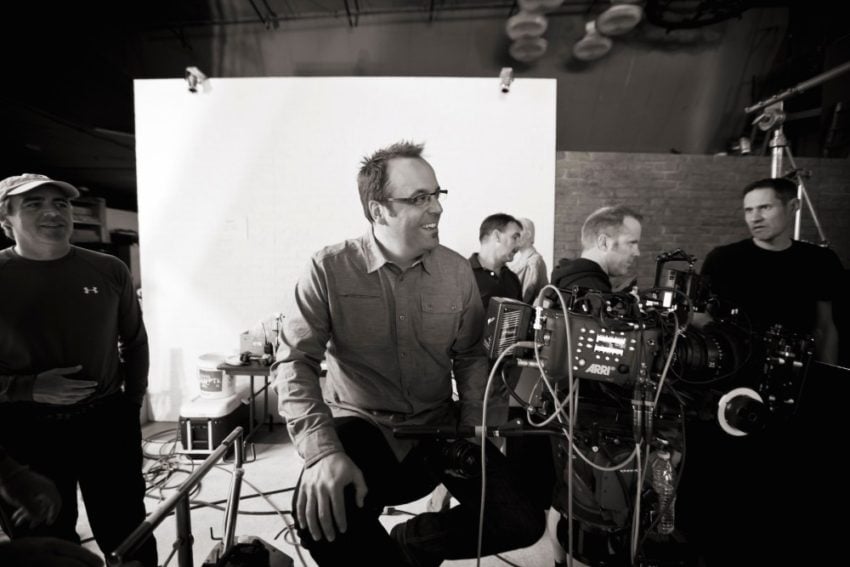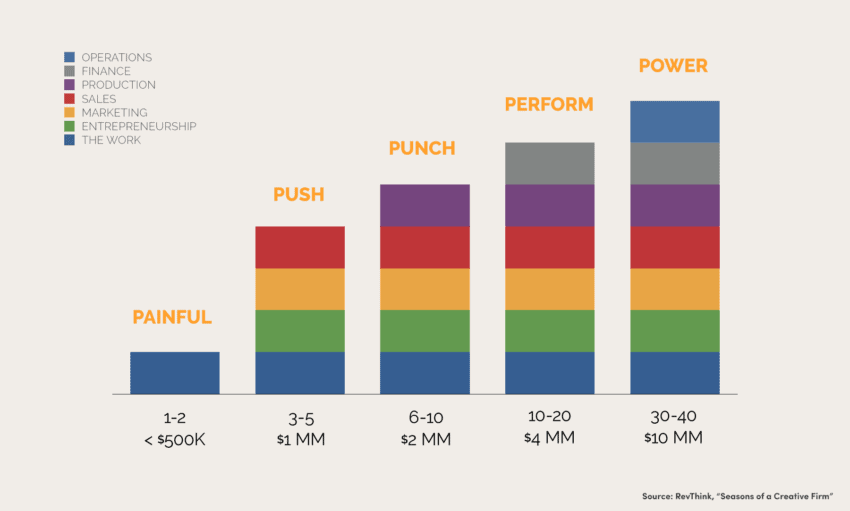30 years ago, the top motion graphics studios could be counted on one hand. Much has changed.
Back then, the industry was dominated by a few post-production companies with the resources and courage to create pioneering work.
But the desktop computing revolution of the late 1990s and early 2000s shattered the barriers to entry. Over a handful of years, hundreds of new players crowded onto the field, eager to topple the Goliaths before them.
Today, there are thousands of entities around the world — some individuals, some multi-national facilities — creating motion design work and making money doing it. Competition is fierce, the landscape is vast and carving out a strategy for success can be an intimidating challenge.

Joel Pilger
RevThink is a consultancy focused on helping motion design and production studios of all sizes thrive. We asked Joel Pilger, founder of Impossible Pictures (which he sold in 2014 after a 20-year run) and now a consultant with RevThink, for his take on the industry.
His thought-provoking insights will be valuable to anyone running their own shop — or hoping to someday.
Q&A with RevThink’s Joel Pilger
The fact that a motion design-friendly consultancy like RevThink exists seems like a signal that the motion design industry has reached some point of maturity. Is that a fair assumption?
The fact that we can safely say that motion design has been around for 20+ years means the industry has matured, yes. And hopefully we have, too, right? ;-)
But Tim Thompson actually started RevThink around 10 years ago, after his years as a founding member at Imaginary Forces, then yU+co and Trailer Park. Since then, he’s worked with clients like Trollbäck, Bigstar, The Ebeling Group, Prologue, Roger and many more.
But to your point, a tipping point was definitely crossed in the past two years since I sold Impossible and joined RevThink, where our collective wisdom is helping the entire industry. And helping it mature.
How would you characterize the industry’s current maturity level?
I like how Tim summarizes the evolution we’ve all witnessed in the industry as “The Generations of Motion Design.”

Remember the original behemoth companies? Names like R/GA, Telezign and Pittard Sullivan? That’s the first generation, and we call them the “Explorers.”
But then came the “Pioneers” of the digital revolution, people like Imaginary Forces, 3 Ring Circus, Eyeball, and even Impossible Pictures, who created a new category.
Then with the desktop revolution came the “Boomers” of the early 2000’s, when new companies could start-up with little overhead, yet they competed very well against the Pioneers.
The next generation we call the “Reinventors” since they were forced to create new revenue streams to survive the post-2008 economic downturn along with client restructurings and increased competition.
That brings us to today’s new studios. We refer to them as the “Developers,” since many of the specialties we practiced 20 years ago have been commoditized or lost their value, these firms are developing new value, innovating new disciplines, as well as creating intellectual property (IP) and assets unavailable to previous generations.
Exit strategies
One of the services you offer is guidance through the world of mergers and acquisitions. But I get a sense that in our post-2008 world, M&A’s are much less common — at least for smaller shops and especially for design shops. Is that a mistaken view?
Are M&A’s less common? That may be a perception, but there are still M&A’s happening today. It’s just that the buzz about acquisitions has shifted. Case in point, I sold Impossible Pictures in 2014 but it wasn’t big news (although it was to me!). I can probably think of five more examples that have happened in the last 18 months.

Impossible Pictures, circa 2011
To answer your deeper question, yes, there is a market for motion design studios. We’re currently working with both large and small studios to get them ready to sell in the next 12 months.
We know there is a market for the them since they’ve already had offers from different sectors like capital groups, larger agencies, competitors and even clients, but 99% of the time the owner hasn’t built a plan and organized their business for the acquisition, much less the transition.
In those cases, we come alongside those owners – who are typically not strong in the area of M&A – and prepare them and their business for the transaction.
If any Motionographer readers are interested in M&A as an exit strategy, we recommend they make a concerted effort to educate themselves and build a plan. Owners often get stuck in a nebulous “someday I’m going to sell!” mindset while ignoring smarter ways to unlock value in their firms right now.
So before there’s any discussion of M&A, we push owners to first pay attention to the market, leverage their firm’s existing value, stimulate growth and prepare for the transition. Then when the opportunity arises, they can recognize it and take advantage of it.
If any Motionographer readers are interested in M&A as an exit strategy, we recommend they make a concerted effort to educate themselves and build a plan.
Speaking from personal experience, I get it: there is never a good time to develop an exit strategy. Owners stay crazy busy. But if I hadn’t been prepared, I would have missed out on a great opportunity that came my way.
For a lot of people, selling their company is the ultimate goal. From a personal perspective, what was it like selling Impossible Pictures? Did you feel like you had “won” in some sense?
What was it like? Well, first and foremost, for me running Impossible Pictures was all about producing outstanding work, building a killer team and making an impact in the industry… all while living life on my own terms (in those days, locating a studio in Denver was unheard of!). It wasn’t about getting a big check someday. So the way I did it, I “won” all along the way.
But some owners do dream of selling as “the ultimate goal.” In my case, it was a gradual realization – around year 18 or 19 – I wasn’t going to allow myself to look back someday and feel I had wasted 20 years investing in something that was worthless.
So realizing my business was an asset – and converting it into one – was far more important than the actual selling of it.
Lucky for me, I met Tim back when I was an owner. He was my consultant through that transition, and that was huge. He was the only person I knew that had worked with owners and studios of all shapes and sizes across the industry. His “4 Stages of a Creative Career” helped me view selling my studio as a good, next logical step.

The RevThink crew: Emmett Armstrong, Joel Pilger, Tim Thompson, Jason Fletcher
Then when an opportunity suddenly arose to sell, it provided me a much-needed inflection point to close that incredible chapter of my life… despite all the bittersweet emotions I was feeling. It was absolutely the right decision.
Looking back on the sale, how do you feel now?
Well, because I work with a wide variety of studios these days, I’ve become more reflective about my place in the industry. Which inspired me to just recently update the old Impossible website to show the legacy of work and just say thank you to everyone that made the journey with me.
Looking back over 20+ years, is there is a roller coaster of feelings? Sure. But there are very few regrets. Mostly, I’m just really thankful for the part I’ve been fortunate to play.
Now that I have gone through it myself, I now know that a merger or acquisition is just another transition in one’s career.
Now that I have gone through it myself, I now know that a merger or acquisition is just another transition in one’s career. Afterwards, there is still more work to do. The owner’s career moves forward. For me, soon after my transition, Tim argued for me to join RevThink.
He said, “Don’t go start another studio. Think of the impact you can have on every studio!” He won the argument. :-)
So creating, teaching, consulting, all focused on giving back to the next generation of studios and production companies, I can wholeheartedly say that I feel like I’ve “won” again. The part I’m playing now is very meaningful. So there it is again: I’m thankful.
How does RevThinking structure its fees? Flat rate? Sales percentage? I’m sure the answer it is “it depends.” I’m just trying to get a sense of how clients decide if they can afford you.
Yes, “it depends” is correct.
At RevThink, we focus on the Creative Entrepreneur. And their needs are different based on which of the “Seasons of the Creative Firm” they are in.
Younger studios with smaller revenue need tons of advice, with a heavy emphasis on marketing and sales. While at larger studios, we typically build integrated systems across all “Seven Ingredients of a Creative Firm” to drive total organizational health.
In those bigger studios, we are immersed as consultants – or even interim CEO – driving many of the routines needed to accomplish the big picture goals. So to serve both small and larger studios, our most common fee structure is a monthly retainer plus a sliding scale tied to the studio’s growth.
But in addition to monthly engagements, we work in several others ways. One, we publish content around the world through our blog and podcast. Two, we spearhead a series of one-day conferences called Creative Entrepreneurs in partnership with PromaxBDA. Three, we are launching a new online mentoring program specifically to help small studios, called Creative Studio Jumpstart.
Together, these efforts are delivering on our mission to help the entire industry become stronger… from solopreneurs all the way up to the large studios.
Identifying your Season
I found your “Seasons of the Creative Firm” article very compelling. I’ve worked at a studio in nearly every Season. The pros and cons you list are uncannily accurate.
You’ve obviously been part of some wild ups and downs like many of us! I find the concept fascinating, too.
It arose from the patterns that Tim and I noticed over the years, having worked with many creative firms and seeing the striking similarities in how they evolve.
The secret to “Seasons of the Creative Firm” is not viewing it as a strategy, or even a goal. Rather it’s a tool to help an owner recognize the Season he/she is currently in and realize that their crazy challenges are very normal. In short, you’re not crazy!
Next, it’s helpful to carefully consider which disciplines (we call them “Ingredients” and there are no less than seven of them) you will need to master as your studio moves into the next Season, as well as the pros and cons that go with that, i.e., not all growth is good.
In which season are the majority of your clients?
They span the gamut. We are working with a few studios to help push them through the Push Season, several are crushing it in the Power Season, but most are in the Punch and Perform Seasons.
Since you guys are engaged in multiple firms in all regions, what universal trends to recognize about businesses or our industry? And what encouragement would you want to leave our readers with?
For those of us that have been in the industry for a long time, there has been this constant, depressing drumbeat of, “Well, things aren’t like they used to be…” and “every year demands go up, but budgets go down…”
I’m so glad that conversation is all but dead. This may sound funny, but I think while the old guard has been busy whining, the next generation just rolled up their sleeves and got busy making it happen.
Today’s successful studios are leveraging a combination of talent and technology to produce small-budget projects with less overhead yet still generate strong profits. They are also ignoring traditional job titles and instead merging creative, production, and technology roles.
So it’s not uncommon to hear that a post-producer is also directing a live-action commercial or a salesperson did the copywriting. We call it “The Slash Model,” and if you think it sounds absurd, watch out.
While the old guard has been busy whining, the next generation just rolled up their sleeves and got busy making it happen.
Another trend we are seeing is a gradual shift away from the classic “work for hire” business model, where the end client owns it all and your studio owns nothing. Today’s shrewd studio owners – a.k.a. The Developers – are entering into smart partnerships, doing pay-for-performance deals, dynamic pricing models, even using their branding and promotion prowess to launch new products and services in which they materially participate.
We’re inspired by this slightly reworded quote from Peter Drucker: “The best way to deal with the future is to create it.”
So the big encouragement I would leave with Motionographer readers is to be strategic, intentional, and proactive with their businesses – and their careers – so they can steal every opportunity within our changing industry.
And naturally, if they have questions, they should contact us. We like helping.







